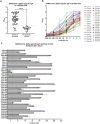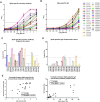The IgA in milk induced by SARS-CoV-2 infection is comprised of mainly secretory antibody that is neutralizing and highly durable over time
- PMID: 35263323
- PMCID: PMC8906612
- DOI: 10.1371/journal.pone.0249723
The IgA in milk induced by SARS-CoV-2 infection is comprised of mainly secretory antibody that is neutralizing and highly durable over time
Abstract
Approximately 10% of infants infected with SARS-CoV-2 will experience COVID-19 illness requiring advanced care. A potential mechanism to protect this population is passive immunization via the milk of a previously infected person. We and others have reported on the presence of SARS-CoV-2-specific antibodies in human milk. We now report the prevalence of SARS-CoV-2 IgA in the milk of 74 COVID-19-recovered participants, and find that 89% of samples are positive for Spike-specific IgA. In a subset of these samples, 95% exhibited robust IgA activity as determined by endpoint binding titer, with 50% considered high-titer. These IgA-positive samples were also positive for Spike-specific secretory antibody. Levels of IgA antibodies and secretory antibodies were shown to be strongly positively correlated. The secretory IgA response was dominant among the milk samples tested compared to the IgG response, which was present in 75% of samples and found to be of high-titer in only 13% of cases. Our IgA durability analysis using 28 paired samples, obtained 4-6 weeks and 4-10 months after infection, found that all samples exhibited persistently significant Spike-specific IgA, with 43% of donors exhibiting increasing IgA titers over time. Finally, COVID-19 and pre-pandemic control milk samples were tested for the presence of neutralizing antibodies; 6 of 8 COVID-19 samples exhibited neutralization of Spike-pseudotyped VSV (IC50 range, 2.39-89.4ug/mL) compared to 1 of 8 controls. IgA binding and neutralization capacities were found to be strongly positively correlated. These data are highly relevant to public health, not only in terms of the protective capacity of these antibodies for breastfed infants, but also for the potential use of such antibodies as a COVID-19 therapeutic, given that secretory IgA is highly in all mucosal compartments.
Conflict of interest statement
The authors have declared that no competing interests exist.
Figures




Similar articles
-
The Secretory IgA Response in Human Milk Against the SARS-CoV-2 Spike Is Highly Durable and Neutralizing for At Least 1 Year of Lactation Postinfection.Breastfeed Med. 2023 Aug;18(8):602-611. doi: 10.1089/bfm.2023.0117. Breastfeed Med. 2023. PMID: 37615565 Free PMC article.
-
Immune Response of Neonates Born to Mothers Infected With SARS-CoV-2.JAMA Netw Open. 2021 Nov 1;4(11):e2132563. doi: 10.1001/jamanetworkopen.2021.32563. JAMA Netw Open. 2021. PMID: 34730817 Free PMC article.
-
Clinical validation of the Siemens quantitative SARS-CoV-2 spike IgG assay (sCOVG) reveals improved sensitivity and a good correlation with virus neutralization titers.Clin Chem Lab Med. 2021 Apr 9;59(8):1453-1462. doi: 10.1515/cclm-2021-0214. Print 2021 Jul 27. Clin Chem Lab Med. 2021. PMID: 33837679
-
Titres and neutralising capacity of SARS-CoV-2-specific antibodies in human milk: a systematic review.Arch Dis Child Fetal Neonatal Ed. 2022 Mar;107(2):174-180. doi: 10.1136/archdischild-2021-322156. Epub 2021 Jul 13. Arch Dis Child Fetal Neonatal Ed. 2022. PMID: 34257103
-
The Antiviral Properties of Human Milk: A Multitude of Defence Tools from Mother Nature.Nutrients. 2021 Feb 22;13(2):694. doi: 10.3390/nu13020694. Nutrients. 2021. PMID: 33671491 Free PMC article. Review.
Cited by
-
Survival of Vaccine-Induced Human Milk SARS-CoV-2 IgG, IgA and SIgA Immunoglobulins across Simulated Human Infant Gastrointestinal Digestion.Nutrients. 2022 Aug 17;14(16):3368. doi: 10.3390/nu14163368. Nutrients. 2022. PMID: 36014873 Free PMC article.
-
Impact of Maternal Exposure to SARS-CoV-2 on Immunological Components of Breast Milk.Int J Mol Sci. 2025 Mar 13;26(6):2600. doi: 10.3390/ijms26062600. Int J Mol Sci. 2025. PMID: 40141241 Free PMC article. Review.
-
The Secretory IgA Response in Human Milk Against the SARS-CoV-2 Spike Is Highly Durable and Neutralizing for At Least 1 Year of Lactation Postinfection.Breastfeed Med. 2023 Aug;18(8):602-611. doi: 10.1089/bfm.2023.0117. Breastfeed Med. 2023. PMID: 37615565 Free PMC article.
-
Anti-SARS-CoV-2 Immunoglobulins in Human Milk after Coronavirus Disease or Vaccination-Time Frame and Duration of Detection in Human Milk and Factors That Affect Their Titers: A Systematic Review.Nutrients. 2023 Apr 14;15(8):1905. doi: 10.3390/nu15081905. Nutrients. 2023. PMID: 37111124 Free PMC article.
-
Factors Influencing Breast Milk Antibody Titers during the Coronavirus Disease 2019 Pandemic: An Observational Study.Nutrients. 2024 Jul 18;16(14):2320. doi: 10.3390/nu16142320. Nutrients. 2024. PMID: 39064762 Free PMC article.
References
-
- Dong Y, Mo X, Hu Y, Qi X, Jiang F, Jiang Z, et al.. Epidemiological Characteristics of 2143 Pediatric Patients With 2019 Coronavirus Disease in China. Pediatrics. 2020.
Publication types
MeSH terms
Substances
Grants and funding
LinkOut - more resources
Full Text Sources
Miscellaneous

